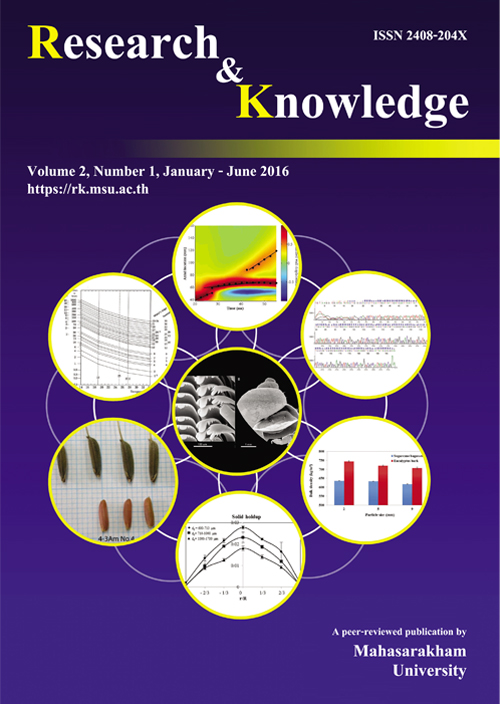Situation of liver fl uke and cholangiocarcinoma among patients and risk groups of liver fl uke in Maha Sarakham Province, Thailand
Keywords:
Liver fluke, cholangiocarcinoma, patients, risk group of liver flukeAbstract
The objective of this point cross-sectional study was to explore the situation of liver fl uke, cholangiocarcinoma, preventive behaviors and other health-risk behaviors among patients and risk groups of liver fl uke at Nadoon Municipality, Nadoon District, Maha Sarakham Province, Thailand. A simple random sampling technique was used for selecting 1,148 villagers from 10 villages of Nadoon District, which was carried out from January 2014 to February 2014. All subjects were interviewed. Results showed that the incidence rate of liver fl uke was 2.3% and the cholangiocarcinoma incidence rate was 2.8%. The subjects were female (53.2%), married (81.3%) and older (40-60 years) (68.3%). Most of them had a primary school education level (69.9%), were agriculturists (68.6%), families had 3-4 persons (41.9%) and had monthly family incomes lower than 5,000 Baht (72.9%). The largest source of information about liver fl uke was 80.7% from public health personnel and 77.5% from television/radio. Raw fi sh dishes were among the favorite foods with a medium period of intake of 34.0 years, which comprise of more than 50% intake of bonnelville raw fi sh (jaew bong), orange little fi sh (som pla noi), food with raw pickled fi sh, raw fi sh consumed (mam) and raw pickled fi sh (pla jom), (range 53.7%-81.8%). The rest consumed it in the range from 9.2%-43.4%, such as raw fermented fi sh (som pla), minced fermented fi sh with chili paste and raw fi sh with spiced salad (koi pla). Stool exams were performed for the detection of liver fl ukes (27.4%). Liver fl uke anthelmintic drug intake was by 31.3%, who obtained it manly from health services as 42.1%. Although many control programs have been used among them, the incidence of reinfection remained the same. Precise and regular main raw fi sh dishes, drug intake, hygienic defecation data directly from public health personnel and television/ radio should be strong concerned with suffi cient diagnosis and treatment.
References
Aunpromma, S., Tangkawattana, P., Papirom, P., Kanjampa, P., Tesana, S., Sripa, B. and Tangkawattana, S. 2012. High prevalence of Opisthorchis viverrini infection in reservoir hosts in four districts of Khon Kaen Province, an opisthorchiasis endemic area of Thailand. Parasitology International 61, 60-4.
Grundy-Warr, C., Andrews, R. H., Sithithaworn, P., Petney, T. N., Sripa, B., Laithavewat, L. and Ziegler, A. D. 2012. Raw attitudes, wetland cultures, lifecycles: socio-cultural dynamics relating to Opisthorchis viverrini in the Mekong Basin. Parasitology International 61, 65-70.
International Development Research Centre (IDRC). 2015. Reducing liver fl uke transmission in northeastern Thailand. ScienceDaily.
Kaewpitoon, N., Kaewpitoon, S., Pengsaa, P. and Sripa, B. 2008. Opisthorchis viverrini: The carcinogenic human liver fluke. World Journal of Gastroenterology 14, 666-674.
Lovis, L., Mak, T. K., Phongluxa, K., Ayé Soukhathammavong, P., Vonghachack, Y., Keiser, J., Vounatsou, P., Tanner, M., Hatz, C., Utzinge, J., Odermatt, P. and Akkhavong, K. 2012.
Effi cacy of praziquantel against Schistosoma mekongi and Opisthorchis viverrini: a randomized, single-blinded dose-comparison trial. PLOS Neglected Tropical Diseases 6, e1726.
Pitaksakulrat, O., Sithithaworn, P., Laoprom, N., Laha, T., Trevor, N., Petney, T. N. and Andrews, R. H. 2013. A cross-sectional study on the potential transmission of the carcinogenic liver fl uke Opisthorchis viverrini and other fi shborne zoonotic trematodes by aquaculture fi sh. Foodborne Pathogens and Disease 10, 35-41.
Prasongwatana, J., Laummaunwai, P., Boonmars, T. and Pinlaor, S. 2013. Viable metacercariae of Opisthorchis viverrini in northeastern Thai cyprinid fi sh dishes-as part of a rational program for control of O. viverrini-associated cholangiocarcinoma. Parasitology Research 112, 1323-1327.
Saengsawang, P., Promthet, S. and Bradshaw, P. 2013. Infection with Opisthorchis viverrini and use of praziquantel among a working-age population in northeast Thailand. Asian Pacifi c journal of cancer prevention 14 (5), 2963-2966.
Sithithaworn, P., Andrews, R. H., Nguyen, V. D., Wongsaroj, T., Sinuon, M., Odermatt, P., Nawa, Y., Liang, S., Brindley, P. J. and Sripa, B. 2012.The current status of opisthorchiasis and clonorchiasis in the Mekong Basin. Parasitology International 61, 10-6.
Sithithaworn, P. 2014. Fighting the liver fl uke and cholangiocarcinoma (CCA) through school health education. Department of Parasitology and the Liver Fluke and Cholangiocarcinoma Research Center, Faculty of Medicine, Khon Kaen University, Thailand. AMMF the cholangiocarcinoma charity. http:// ammf.org.uk/article-6-cc-in-thailand/
Sithithaworn, P., Yongvanit, P.,Duenngai, K., Kiatsopit, N. and Chawalit Pairojkul, C. 2014. Roles of liver fl uke infection as risk factor for cholangiocarcinoma. Journal of Hepato-Biliary-Pancreatic Sciences 21, 303-308.
Sripa, B., Kaewkes, S., Sithithaworn, P., Mairiang, E., Laha, T., Smout, M., Pairojkul, C., Bhudhisawasdi, V., Tesana, S., Thinkamrop, B., Bethony, J. M., Loukas, A. and Brindley, P. J. 2007. Liver fl uke induces cholangiocarcinoma. PLOS Medicine 4, e201.
Sripa, B. 2008. Concerted action is needed to tackle liver fl uke infections in Asia. PLOS Neglected Tropical Diseases 2, e232.
Suwannahitatorn, P., Klomjit, S., Naaglor, T., Taamasri, P., Rangsin, R., Leelayoova, S. and Mungthin, M. 2013. A follow-up study of Opisthorchis viverrini infection after the implementation of control program in a rural community, central Thailand. Parasit Vectors 6, 188.
Upatham, E. S., Viyanant, V., Kurathong, S., Brockelman, W. Y., Menaruchi, A., Saowakontha, S., Intarakhao, C., Vajrasthira, S. and Warren, K. S. 1982. Morbidity in relation to intensity of infection in Opisthorchiasis viverrini: study of a community in Khon Kaen, Thailand. American Journal of Tropical Medicine and Hygiene 31, 1156-63.
Downloads
Published
How to Cite
Issue
Section
License

This work is licensed under a Creative Commons Attribution-NoDerivatives 4.0 International License.






